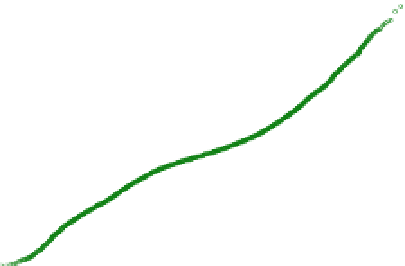Geoscience Reference
In-Depth Information
Fig. 6 The quantiles of the
standardized horizontal (zonal)
derivatives (
r
x
Z) of the true HR
field (red 9), the LR observation
(black ?), the VarD downscaled
field (green
j
), and the SPaD
downscaled field (blue h) versus
standard normal quantiles. The
broken straight line represents
quantiles of the Gaussian
distribution. It is observed that
both downscaling methodologies
are able to reproduce the extreme
reflectivity gradients
10
True (high-res.)
SPaD
8
6
4
2
Obs. (low-res.)
0
VarD
-2
-4
-6
-8
-10
-5
-4
-3
-2
-1
0
1
2
3
4
5
Standard Normal Quantiles
downscaled field and is able to enhance substantially the tails of the low-resolution rainfall
fields. One of the reasons for reproducing extreme rainfall intensities is that typically
extreme gradients are collocated with high rainfall intensities. This was observed and
documented by Perica and Foufoula-Georgiou (
1996
) and is also documented for the
Claudette storm in Fig.
8
. So, indirectly, VarD is bound to preserve satisfactorily the tails
of the PDF of precipitation intensities. From Fig.
7
, it is apparent that SPaD outperforms
VarD in preserving extreme rainfall. This is attributed to the fact that, in SPaD, the
operator is learned directly on the precipitation intensities, and not on the gradients,
allowing thus for a more direct reconstruction of extreme intensities, provided that such
extremes are available in the data base.
Table
1
presents a comparison of the downscaling methodologies in terms of several
quantitative metrics: the mean square error: MSE
¼
x
x
k
2
= kk
2
, the maximum abso-
k
lute
error:
MAE
¼
x
x
k
k
1
= kk
1
,
the
peak
signal-to-noise
ratio:
PSNR
¼
20 log
10
max
½
ðÞ=
std x
x
ð
Þ
,
and
the
Kullback-Leibler
divergence:
KLD p
x
jj
p
x
ð Þ ¼
R
i
ln p
x
ð
i
Þ=
p
x
ð
i
½
p
x
ð
i
Þ
or relative entropy metric, where p
x
(i) and p
x
ð
i
Þ
are
the discrete probabilities of the true and estimated rainfall, respectively. The KLD is a non-
negative measure that represents a relative degree of closeness of two PDFs in terms of
their entropy, while smaller values signify a stronger degree of similarity. It can be seen
from Table
1
that both downscaling methods produce HR fields that are closer to the true
field compared to the LR field and that the VarD and SPaD methods considerably out-
perform the ''na¨ve'' simple downscaling methods such as the result obtained by the
bicubic interpolation scheme. SPaD is seen to outperform VarD in terms of the entropy
metric (smaller KLD value) further speaking for the better reproduction of very extreme
rainfall intensities.
It is worth presenting here some extra insight into the effect of a misdiagnosed
observation filter H on the downscaled field. As shown in the illustrative example of Fig.
9
,
when the observation operator is smoother (a Gaussian filter) as compared to the operator
used in the VarD downscaling (a box average filter), the downscaled field exhibits a


























































































































